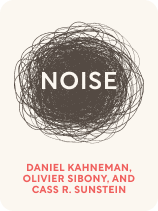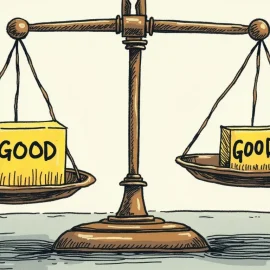

This article is an excerpt from the Shortform book guide to "Noise" by Daniel Kahneman, Olivier Sibony, and Cass Sunstein. Shortform has the world's best summaries and analyses of books you should be reading.
Like this article? Sign up for a free trial here .
What causes noise in human judgment? Is noise purely psychological, or are there societal causes of noise as well?
Noise, as described in the book Noise by Daniel Kahneman, Olivier Sibony, and Cass R. Sunstein, is the variability in human judgment. For example, a judge’s mood or hunger level at the time of sentencing could be an example of noise.
Here’s a look at what causes noise, human judgment’s enemy.
Where Noise Comes From
Once we understand what noise in human judgment is and why it matters, we can move toward finding ways to reduce it. But to do so effectively, we need to look more closely at where noise comes from. We’ve already seen a few sources of noise–such as personal biases (preferences, backgrounds, affiliations, beliefs, and so on) that lead to level noise and pattern noise, as well as the more random factors (mood, weather, the order or timing of decisions or information, and so on) that contribute to occasion noise. In addition, noise occurs because of the way our minds see the world and because of the way we act in group situations.
(Shortform note: A lot of the ideas in this section reflect Kahneman’s previous work in Thinking, Fast and Slow. Noise acknowledges these connections but mostly glosses over them. We spell them out more clearly below since they help clarify the ideas in this section.)
Psychological Source #1: Cause and Effect Thinking
The authors argue that a major reason why our judgments are noisy is that we think about the world in terms of cause and effect. This is also why we don’t notice noise and have a hard time understanding it when it’s pointed out: noise is statistical and made up of many cases, whereas our minds tend to consider one case at a time.
This preference for causality is misleading because it’s shaped through the lens of hindsight. Once an outcome is known, we examine what we know about the situation and attribute one or more of those factors as the cause of the outcome. The authors point out that most events are neither completely surprising nor completely expected. We don’t give much consideration at all to these “normal” events, and as a result, it seems like they would have been completely predictable–when in reality, we couldn’t have reliably predicted them had we tried.
Because we think the causes of everything that happens around us are obvious and inevitable, we think we can predict things. We don’t see just how arbitrary and contingent most events are (at least from the perspective of prediction). The authors explain that this is because the relevant causes often only become known at the same moment the outcome is known.
| The Narrative Fallacy These ideas are related to the narrative fallacy from Thinking, Fast and Slow, whereby we explain occurrences as though they fit a coherent story, when in fact they may have been completely random. Imagine that a company conducted a round of layoffs by firing employees whose names were drawn out of a hat. If you didn’t know how the layoffs were decided, and if one of the fired employees was your friend, you might recall an argument your friend recently had with her boss and assume the boss had it out for her. If, on the other hand, the employee in question was someone you didn’t like much, perhaps you’d attribute the firing to some deficiency in skill or character. In either case, you would probably conclude that the firing made logical sense (even if it was unfair) and believe that it was foreseeable; in reality, it was entirely random. |
Psychological Source #2: Matching Operation
Another source of noise arises from an intuitive matching operation by which we attempt to predict or evaluate something by comparing it to similar things we have more information about. This operation introduces noise because of the oversimplifications inherent in the procedure, as well as the limit on our ability to discern quantitative differences with any great resolution. (Shortform note: This is a type of heuristic, a concept explored in Thinking, Fast and Slow. A heuristic is an operation our mind performs to solve a difficult problem quickly. Specifically, the mind tries to substitute something easier or more familiar to generate an answer.)
For example, you can tell if it’s sunny or cloudy out. That’s a qualitative judgment: Are there clouds in the sky or not? You can generally tell if it’s hot or cold, too. But if you were exposed to a series of different temperatures and asked to rank them from coldest to warmest, you would quickly make mistakes. (According to the authors, studies have found that we can rank things into about seven levels of quality or intensity before we start to make ranking errors.) You’ll do okay if you can directly compare one item to another, but given a set of items and asked to rank or categorize them, you’ll make errors more easily than you’d think.
Finally, the authors point out that any type of judgment that requires assessing things on a scale becomes noisier as the scale becomes less defined. Without proper context and a shared frame of reference for what values mean and how they should be assigned, judgers are forced to guess in a way that makes the judgment arbitrary. Since each person guesses differently, the scale becomes noisy. (Shortform note: We’ll explore ways to improve rating scales later in this guide.)
Social Sources of Noise
Not only do we each produce our own noise through the way we understand the world, but when people work in groups to reach judgments, social factors add new sources of noise.
For one thing, popularity (real or perceived) affects how people view information. An idea that receives public support or popularity early on is more likely to succeed, regardless of the idea’s inherent merit. This phenomenon is called an information cascade. When one person shares an opinion, the next speaker is more likely to agree with that person unless they have good reasons not to. The effect becomes stronger with each person who gets on board with the initial opinion. When a group is making a judgment, many people might start out undecided or with mixed feelings. Their decision, therefore, is usually determined by the opinion that began the information cascade.
Because most people are in agreement at the end of the process, we think the outcome was inevitable—but it wasn’t. Given a different starting point, a different outcome could have occurred. This isn’t obvious to us because each real-world situation (like this one) only plays out once.
Groups are also susceptible to polarization, which means that members move to a more extreme version of their initial opinions. If each member of a hiring committee feels mildly enthusiastic about candidate A, by the end of the meeting, they might now feel passionately excited about candidate A. Conversely, if some members feel mildly enthusiastic about candidate A while others feel mildly enthusiastic about candidate B, then the polarizing effect could lead to a stalemate in which half the committee strongly supports A while strongly opposing B, and vice versa.
| Overcoming Groupthink Information cascades and polarization can also feed into each other. Through random chance, the first speaker influences the group in a certain direction (starting an information cascade), and then the polarization effect ensures that the group moves decisively in that direction—even if no member of the group felt particularly decisive about any direction when they came into the meeting. The interaction between these two phenomena might be one source of what’s traditionally been called “groupthink.” In Originals, Adam Grant argues that in a corporate setting, groupthink also directly results from the company’s attitudes toward dissenting voices. In these settings, being transparent, inviting dissent, and choosing leaders who genuinely welcome criticism can all help reduce the risk of groupthink when making decisions. These principles are worth keeping in mind when we discuss the wisdom of crowds later in this guide. You can only tap into crowd wisdom when a group consists of people with different viewpoints and when those people feel free to voice their ideas. |

———End of Preview———
Like what you just read? Read the rest of the world's best book summary and analysis of Daniel Kahneman, Olivier Sibony, and Cass Sunstein's "Noise" at Shortform .
Here's what you'll find in our full Noise summary :
- A deep dive into the unexpected and unwanted variance in human judgments
- How to reduce or eliminate noise from your decision-making
- How to practice good decision hygiene






